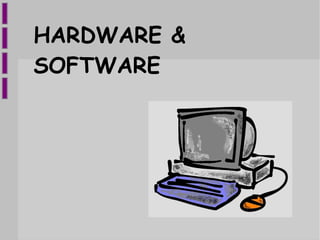
Hardware & Software
- 2. 1. Definition We define 'Computing science' as the automatic treatment of information by the use of computers. A computer is made up of two main parts: ● Hardware: every physical part (touchable) of the computer. They may be in or out of the CPU (Central Process Unit) ● Software: untouchable components of the computer. It compiles all the logic instructions that the system uses to do different tasks
- 3. 2. Hardware A hard, plastic film that contains every electronic circuit and connection where all the devices are switched. 2.1. CPU components a) MOTHER BOARD
- 4. It's the main storage system. We may find more than one, and it contains all the information required by the computer. This information is not lost after switching off the power. Think of it as the computer's brain. It does every mathematical and logical operation. One of its main features is the processing speed, defined as the number of operations it is able to do in a second. b) HARD DISC c) PROCESSOR
- 5. 2. Hardware They are used to stablish communication between the user and the computer and depending on the direction of the flow of information, we have different types 2.2. Peripherals
- 6. a) Input peripheral: b) Output peripheral: c) Input-Output peripheral: used by the user to enter data to the processor Examples: keyboard, mouse, microphone, scanner, etc. used by the processor to give information to the user Examples: printer, screen, Loudspeakers, etc. . used by the processor to give information to the user and vice versa Examples: router, touchable screen, etc.
- 7. If we want to have a data transmission with the computer, we need to have special hardware to connect the specific peripheral to the CPU. This type of device is called a port. There are different types of ports. Usually, you find most of them in the back side of your computer. In the picture, you can see the most common: Ports
- 8. 2. Hardware Depending on their portability, we can find different sorts of storage systems: portable devices: like a pen drive, a storage card, CD/DVD...They may be easily carried. non portable devices: hard disk and the RAM memory, both attached to the mother board. There are others . This is one of the elements that has changed a great deal in recent years. The first device could store 514 kbytes and now you can find little cards with 32 Gbytes... incredible isn't it? 2.3. Storage devices
- 9. RAM (Random Access Memory) It only contains the information that the processor needs in the present moment, and it loses its content when the computer is switched off. It cannot be modified (read-only) It stores critical programs that are used to boot the computer ROM (Read – Only Memory) a) Types of memories
- 11. 3. Software The main program of the computer. It has several important functions: a) To coordinate and manage the information flow that runs between the different components, the processor, the hard disk, the peripherals, etc. b) To organize all the information when it is stored in any device, creating documents, files, folders, directories, etc. c) To define the graphic interface in the screen 3.1. Operating system
- 12. There are three operative systems at the current moment: a) Windows was created by Microsoft. It's the most extended OS in its different versions, 98, 2000, XP, Vista, 8 and the latest on e 10. b) LINUX is based on a community where everyone profits from the sharing the knowledge. It is free and many of its applications. Its appearance is very similar to Windows. The best of its versions: UBUNTU c) Mac OS: was created by Apple. It is very extended on graphic design applications.
- 13. 3. Software We may define a program as a list of instructions. When they are executed (we run the program), they do a specific task. We have to know, then, how to talk with the computer. a) Programming language: The language that is used by the person who creates the program. It is written with key words, very similar to the way we write a telegram. b) Machine language: The language that the different parts of the computer use to communicate with eachother. It's a strange code written with zeros and ones, called binary code. The first programs were written directly in this language, because the computers were too simple to interpret complex instructions expressed in human language. 3.2. Programs
- 14. 3. Software Depending on the type of information we manage, we can have different sorts of files, and in order to know what type of file we are managing we have to look the three last letters. They are the extension of the file. Here you have a table showing many of them, as well as the the type of document they represent: ➔ Text Document: .doc / .txt / .odt ➔ Calc Sheet: .xls / .ods ➔ Image: .jpg / .png / .bmp / .gif ➔ Application (program): .exe ➔ Sound file: .mp3 / .wav ➔ Video file: .mp4 / .dvd / .avi ➔ Internet site: .htm 3.3. Files